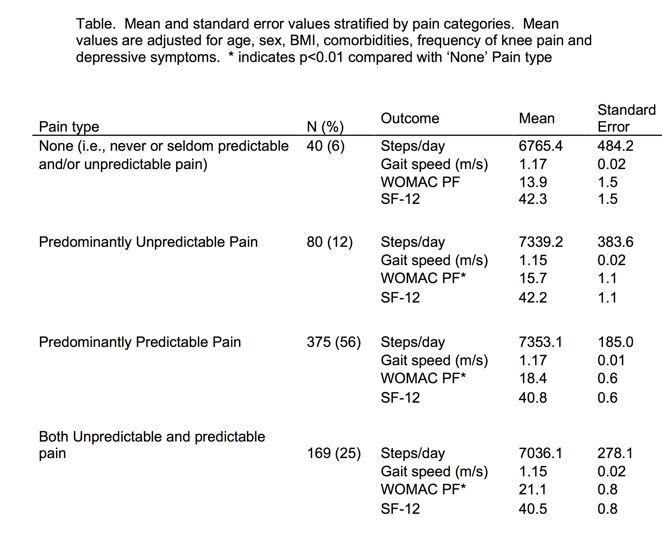Background/Purpose: People with knee osteoarthritis (OA) reported that unpredictable pain restricts their ability to engage in physical activities in a qualitative study. Since walking is the most common physical activity employed by older adults, it would be important to understand if unpredictable pain impacts walking frequency, which would have important health implications. It is also not clear if unpredictable pain contributes to other functional limitations or restrictions in health-related quality of life (HRQOL). We therefore evaluated the association of unpredictable pain with walking frequency, more general function, and physical health related quality of life in people with or at high risk of knee OA.
Methods: The Multicenter Osteoarthritis Study (MOST) is a NIH funded longitudinal study of people who have or are at high risk for knee OA. Participants at the 84-month visit who indicated they had intermittent knee pain were asked to rate the frequency of unpredictable pain, i.e., starts without warning, and the frequency of predictable pain, i.e., starts with a trigger. Both were rated on a Likert scale (Never to Very Often). Participants were categorized as having no pain, predominately unpredictable pain, predominantly predictable pain, or both types according to the worst knee. At the same visit, gait speed over 20 meters, the WOMAC physical function (PF) subscale, and the SF-12 physical function (as a measure of HRQOL) subscale were collected. Steps/day was also collected using a pedometer (Stepwatch) over the next 7 days. We calculated study outcomes according to the presence of unpredictable and/or predictable pain, adjusting for age, sex, BMI, comorbidities, frequency of pain, and depressive symptoms using linear regression.
Results: Of data from the 84-month study visit to date, 664 people had intermittent knee pain (Age 68.5 ± 7.6 yrs, BMI 31.3 ± 6.6 kg/m2, female 70%). Predominantly unpredictable pain was reported in 12%; these subjects had significantly more self-reported functional limitation (WOMAC-PF). However, other outcomes were not statistically significantly different compared with those with no pain. Subjects with predictable pain and both pain types also had worse WOMAC-PF compared with those with no pain, however all other outcomes had values similar to those with no pain. See Table.
Conclusion: While unpredictable knee pain was associated with more self-reported functional limitation, it was not associated with walking ability and frequency, or HRQOL. Similar findings were noted for those with predictable pain. Pain, regardless of its predictability, may not necessarily adversely affect engagement in walking, but does appear to affect self-perceived function.
Table. Mean and standard error values stratified by pain categories. Mean values are adjusted for age, sex, BMI, comorbidities, frequency of knee pain and depressive symptoms. * indicates p<0.01 compared with 'None' Pain type
|
Pain type |
N (%) |
Outcome |
Mean |
Standard Error |
|
None (i.e., never or seldom predictable |
40 (6) |
Steps/day |
6765.4 |
484.2 |
|
and/or unpredictable pain) |
Gait speed (m/s) |
1.17 |
0.02 |
|
|
WOMAC PF |
13.9 |
1.5 |
||
|
SF-12 |
42.3 |
1.5 |
||
|
Predominantly Unpredictable Pain |
80 (12) |
Steps/day |
7339.2 |
383.6 |
|
Gait speed (m/s) |
1.15 |
0.02 |
||
|
WOMAC PF* |
15.7 |
1.1 |
||
|
SF-12 |
42.2 |
1.1 |
||
|
Predominantly Predictable Pain |
375 (56) |
Steps/day |
7353.1 |
185.0 |
|
Gait speed (m/s) |
1.17 |
0.01 |
||
|
WOMAC PF* |
18.4 |
0.6 |
||
|
SF-12 |
40.8 |
0.6 |
||
|
Both Unpredictable and predictable pain |
169 (25) |
Steps/day |
7036.1 |
278.1 |
|
Gait speed (m/s) |
1.15 |
0.02 |
||
|
WOMAC PF* |
21.1 |
0.8 |
||
|
SF-12 |
40.5 |
0.8 |
Disclosure:
D. K. White,
None;
G. A. Hawker,
None;
D. T. Felson,
None;
K. D. Gross,
None;
J. Niu,
None;
M. C. Nevitt,
None;
C. E. Lewis,
None;
J. Torner,
None;
T. Neogi,
None.
« Back to 2012 ACR/ARHP Annual Meeting
ACR Meeting Abstracts - https://acrabstracts.org/abstract/does-unpredictable-intermittent-knee-pain-limit-functional-ability-and-walking-frequency-in-knee-oa/

